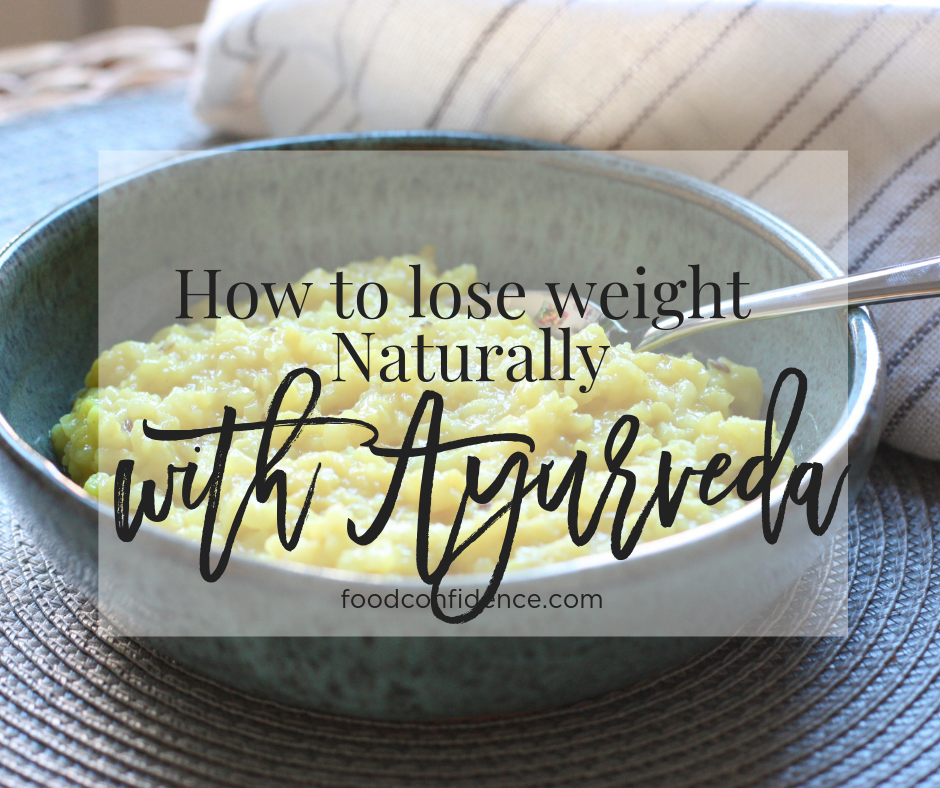
I was so excited to come home and implement all of the amazing stuff I learned from my visit to the Art of Living Retreat Center last month for the Living Light Weight Loss Retreat at the Shankara Ayurveda Spa. You can read part one of my adventure here.
I wasn’t super well-versed in Ayurveda when I arrived, but I feel like I understand my body a whole lot better now!
Learning that I’m a Pitta-Vata type (and what that means in a practical sense) helped to explain many of the experiences I’ve had with food my whole life.
Similar to what I do as an Integrative Dietitian, Ayurveda teaches that by understanding my own body’s unique constitution, I can figure out the best way, the most natural way, to interact with my outer environment. It truly is the science of knowing SELF.
There are a lot more qualified people who can explain to you what Ayurveda is, it’s history, and all the inner workings. Deepak Chopra certainly has more experience than I do on the subject and does a beautiful job!
So for brevity’s sake, this post is my take in a super bite-sized nutshell.
The Five Elements
Ayurveda teaches that there are Five Elements making up the essence of all things in the world: space, air, fire, water and earth. All things in existence contain a varying ratio of these elements — including our bodies! The five elements exist all together inside of us and reflect the way in which we use energy.
The elements have been said to reflect the language of nature with their own distinct characteristics:
Space is the essence of emptiness, it’s the space the other elements fill up. It is light because it lacks the heaviness of earth and water, and it’s cold because it lacks the warmth of fire.
Air is mobile, cool, light, dry, rough, subtle, flowing, sharp, clear, and hard. In the body, air is life. Air allows circulation, movement, and thoughts, and it’s the force behind all motion.
Fire evolves from space and air, containing the essence of these elements within it. Space allows fire to exist within it and air (as oxygen) provides its ability to burn. Fire generates energy in the body, this includes our metabolism and digestion. Fire is hot, light, dry, rough, subtle, flowing, sharp, clear and soft.
Water represents fluidity in the body and it provides vital nourishment. It also soothes pain and inflammation. Water is cool, stable, heavy, moist, smooth, gross, flowing, dull, cloudy, and soft.
Earth gives form to the body. All of the elements are born of space and contained within earth. Earth is cool, stable, heavy, dry, rough, gross, dense, dull, clear, and hard.
What is a Dosha?
Our DOSHA (or body type) is derived from the Five Elements above and their related properties. Vata is composed of space and air, Pitta of fire and water, and Kapha of Earth and Water.
As with the elements, all three doshas are found in varying proportions in everyone and everything! The unique ratio of vata, pitta, and kapha within you is what makes up your constitution. Your dosha provides all the details of your physical, mental, and emotional character traits, as well as your strengths and limitations.
Knowing that I am a mix of all three doshas makes balancing them out super intuitive. In Ayurveda, like increases like and opposites balance. So when any one of my doshas gets out of balance, I can “pacify” those traits or qualities by choosing foods, herbs, and practices that increase the opposing energy.
I am Bi-doshic, which means I share qualities with two doshas: Vata and Pitta. When this happens, one dosha can predominate in certain environments and circumstances. The best way to manage my bi-doshic constitution is by the season. So in the fall and winter I should follow a vata-decreasing protocol and during the spring and summer I should follow a pitta-decreasing regimen. If it’s cold and wet, I should follow kapha.
Once you figure out your constitution, it never changes. What does change though is the balance we feel within our Dosha — and this is reflected by our food and lifestyle choices.
You can figure out your own Dosha here.
What did I eat?
The Living Light Weight Loss Retreat focused mainly on the practices and choices that could help me release weight naturally. During my stay we did yoga twice per day, we walked a lot, and we ate an all-vegan diet without any snacks. We didn’t have any restriction on how much we could eat, but we weren’t really encouraged to eat in-between meals. The focus was on igniting our digestive fire (or agni) and this means taking the time to allow our food to fully digest before eating again. I didn’t snack between meals, but I can tell you I was ready to eat when it was time!
When I travel I tend to get a little irregular, if you know what I mean. This is actually a Vata imbalance. It was recommended I eat more cooked vegetables and warming foods to get balanced. This was actually not easy for me because I love my salads!
We decided the best thing for me to do was a 24-hour cleanse where I ate only only Kitchari. Kitchari is a traditional cleansing food in Ayurveda. It is a warming combination of split mung beans and white basmati rice cooked with ghee and Ayurvedic spices like cumin seed and turmeric. I ate this for breakfast, lunch and dinner for one whole day, but I also had it on the side of many of my meals throughout the week.
Ayurveda also asks that we eat in a peaceful place with a calm mind. I love this because I always tell my clients how important it is to get balanced before eating and not to eat when overly emotional or stressed.
Here are what a few of my meals looked like:

I couldn’t resist throwing some salad on this plate 🙂
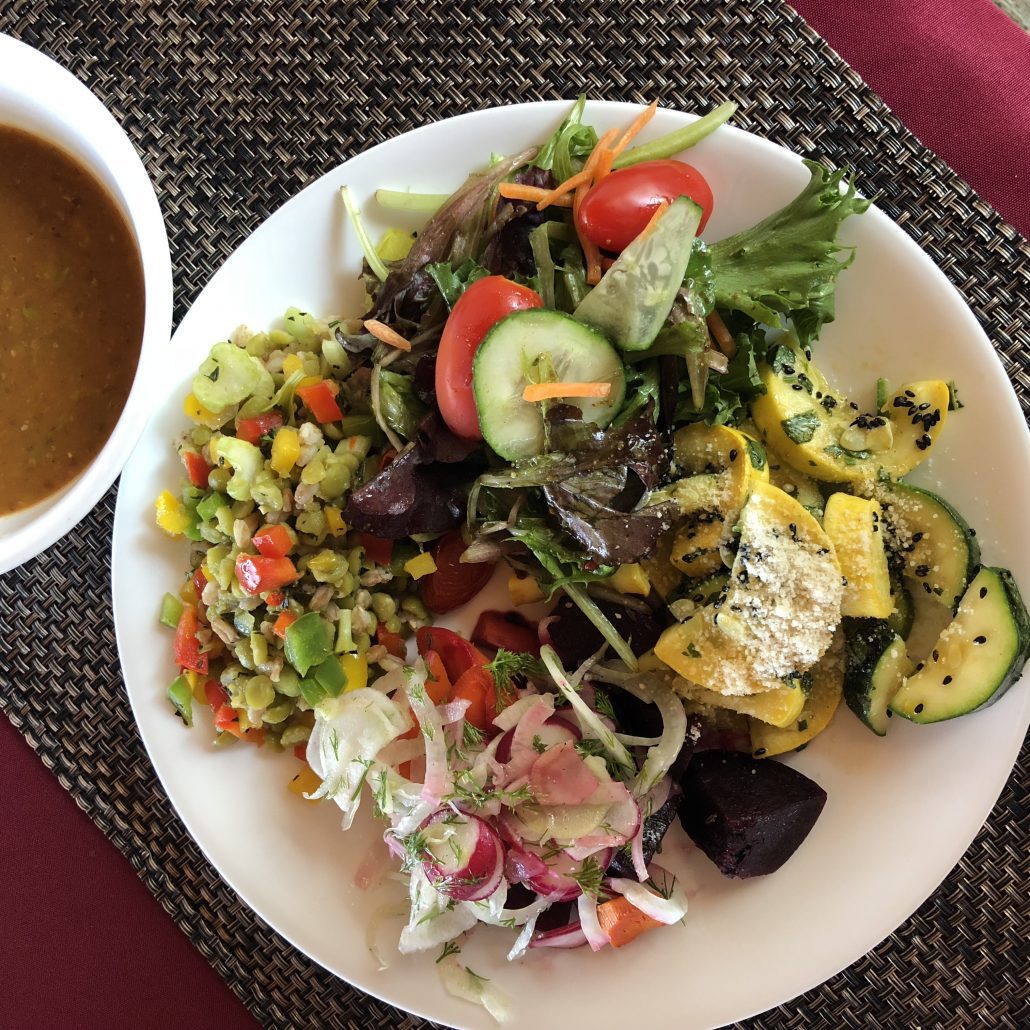
Typical meal containing lots of veggies!

I think I might have eaten something off this plate before I snapped the photo 🙂
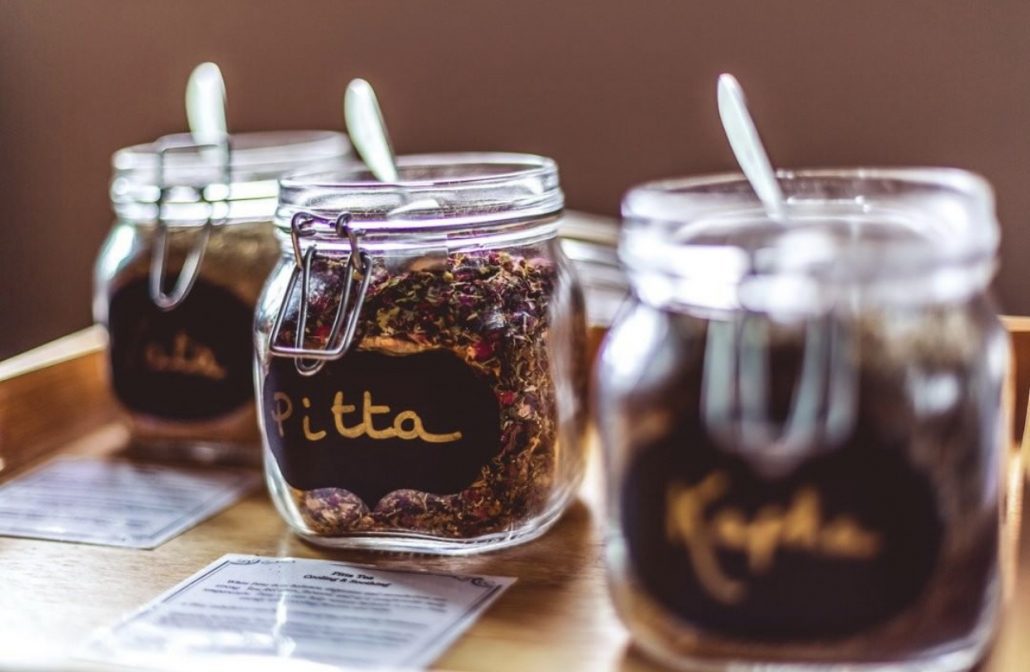
Warm herbal tea was a staple during my stay, I drank it all day long and before bed. I also created my own version of Golden Milk by mixing warmed rice milk with one teaspoon of turmeric.
In Ayurveda you are not supposed to drink very cold or iced water and you don’t drink directly before or after meals. It’s believed that cold water actually diminishes the digestive fire and can lead to problems with digestion. Since I’m not a strong water drinker, I was loving this.
How the Doshas Rule the Day
Every day we cycle through the three doshas (Vata, Pitta, and Kapha) in 4-hour increments, and each increment is influenced by the characteristics of one dosha. I found this really fascinating! It explained a lot for me about the differences in my energy levels and mood during certain times of the day.
Let’s look at how it breaks down and what it meant for me:
Between 6 – 10 am is Kapha time. It’s best to wake up BEFORE the sun for the most energy throughout the day. I’ve started to set my alarm for a gentle wake up around 6:30 am and it’s been working pretty well. Because Kapha has the energy of water and earth, it’s heavy and sluggish, so this is the best time to get some movement in. A quick walk around the block with my dog and a light breakfast help stoke my metabolic fire!
Pitta time is when my digestive fire is at its peak, from 11:30 am – 1:30 pm, so I’ve switched lunch to be my biggest meal of the day. Because Pitta has transformative energy, its fire helps me digest, transforming the food I eat into fuel. During this time I eat whatever I feel like having (mostly grain bowls) and I don’t limit portions. If I’m going to have fish or some lean ground turkey, I will have it during this meal.
Vata time is between 2 – 6 pm and this is a time of transition. This is also the time of day when my Vata energy is most apt to get agitated and/or stressed, so grounding is super important for me here. I make sure to take a break mid-day in a calming space with a cup of herbal tea and listen to or read something that balances me out. I try not to schedule client calls or have meetings during this block of time.
Kapha comes back around again between 6 – 10 pm. Again, the heavier qualities of Kapha suggest a lighter dinner. Dinner is supposed to be more of a “supplemental” meal rather than the biggest biggest meal of the day. I’ve made this switch as well and do notice I sleep better and have less digestive issues at night.
The time of day we get the highest quality of sleep is between 10 pm – 2 am, when we cycle back to Pitta time. This is because Pitta time is an active time, and when sleeping we are actively cleansing the body. Because of this, I try to be horizontal by 10:00 pm on most nights!
The last phase of our 24-hour body clock is from 2 – 6 am. This is Vata time once again. Since I am asleep I don’t do anything actively during this time – except dream. 🙂
Eating for my Dosha
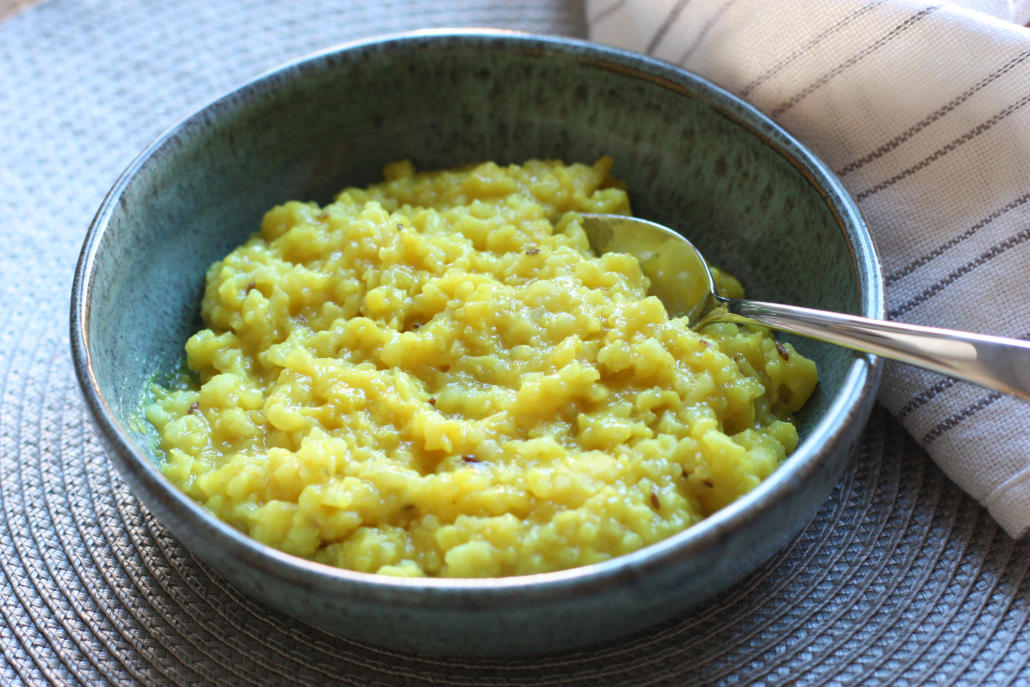
I have been studying all the things Pitta-Vata related since I’ve been back and I’ve made some significant changes to my diet.
For one, I’ve been eating more cooked vegetables and grains to balance my Pitta energy. As I mentioned above, I’ve also made lunch my biggest meal of the day. These two changes alone have made a big difference in my energy level and my mood. I feel more calm throughout the day and have less stress and worry. So cool, right?
Another great take-homes from my trip to the Art of Living Retreat was learning how to make Kitchari. I made it with my Instant Pot and it came out delicious! I followed the same directions from the chef at the retreat center using the saute feature of the pot and cooked it on high pressure for 20 minutes, with a natural release.
I was just getting over a stomach bug so I thought it was the perfect time to complete a 24-hour Kitchari cleanse. It definitely helped to balance me out and I felt like my normal self after the 24-hours. I will continue to do these mini 24-hour cleanses as needed to keep my body in flow.
Here’s how I made it:
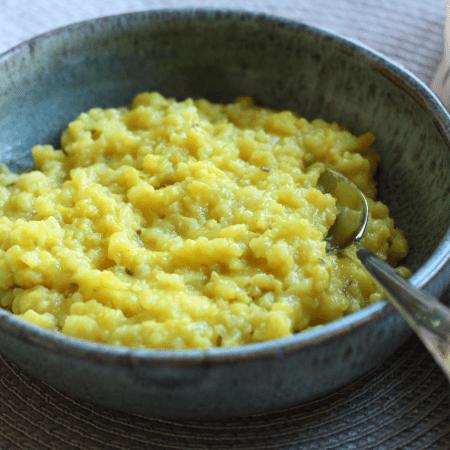
Instant Pot Kitchari
Ingredients
- 1 cup Basmati rice
- 1/2 cup yellow lentils (moong dal)
- 2 tbsp ghee
- 1 1/2 tsp cumin seeds
- 1 tsp turmeric
- 1 1/2 tsp sea salt
- 1 bay leaf
- 4 curry leaves
- 6 cups water
Instructions
- Choose the sauté button on your Instant Pot and add the ghee to the bottom. Once melted, add the cumin seeds and the bay leaf. When the cumin seeds turn brown, add the turmeric and salt. Then add the rice and lentils. Stir well and let brown for 1-3 minutes. Add the water and give it another stir. Secure the lid on the Instant Pot and set the the pressure valve for a natural release. Cook for 20 minutes at high pressure.While it's cooking, saute the curry leaves in ghee until crispy. After about 20 minutes of natural pressure release, open the valve to release anything remaining.Serve each bowl with a spoonful of ghee and sauteed curry leaves.
Once again, I thank the Art of Living Retreat Center for a wonderful experience. If you’re interested in learning more about the retreat center, Click here.
The Living Light programs will teach you sustainable lifestyle habits that will help guide you toward your ideal body weight and optimal health.
The dates for the next Living Light Weight Loss Programs in 2o19 are below:
February 3-8
March 3-8
November 10-15
December 1-6
Click here to learn more!